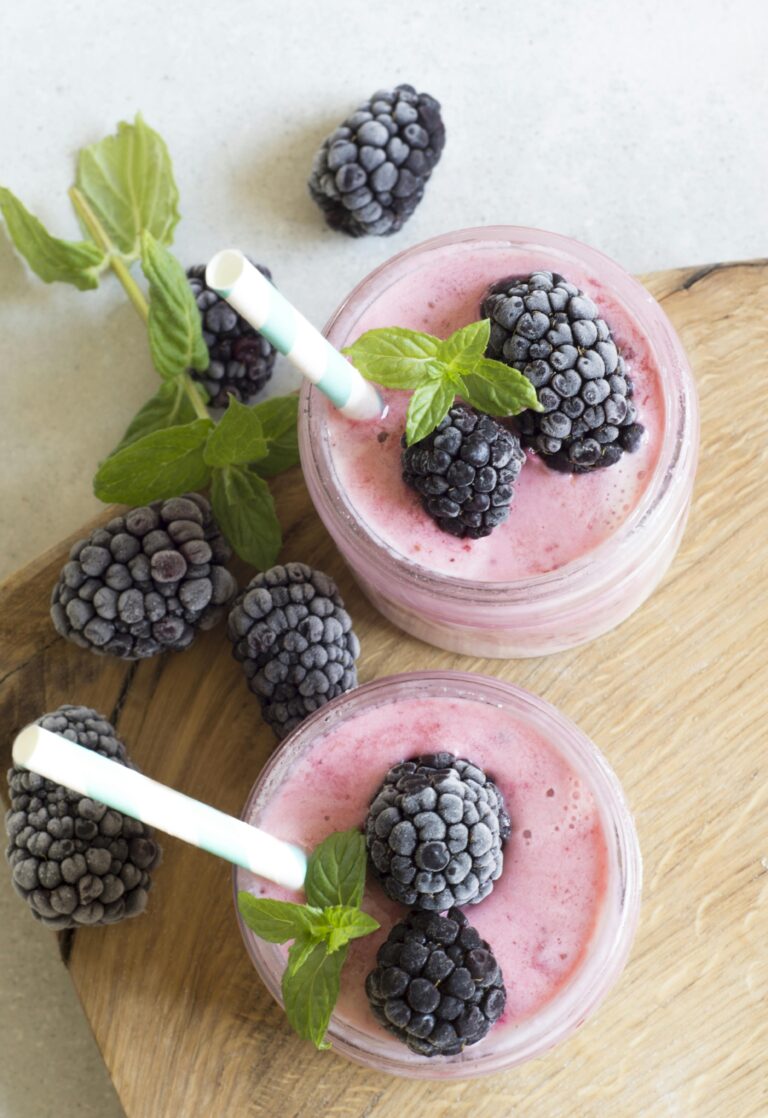Key Takeaways
- Probiotics are essential for a healthy gut; they can be easily incorporated into your diet through smoothies.
- A gut health smoothie recipe can include a variety of ingredients like yogurt, kefir, bananas, and berries.
- Fiber-rich ingredients such as chia seeds or flaxseeds can enhance the benefits of your gut health smoothie.
- Simple, natural ingredients are key to creating an effective gut health smoothie that’s both tasty and beneficial.
- Starting your day with a probiotic-rich smoothie can lead to improved digestion and overall wellness.
Why Your Gut Health Matters
Your gut is more than just a food processor; it’s the core of your immune system and your health’s headquarters. A balanced gut microbiome supports digestion, absorption of nutrients, and helps fend off illness. That’s why it’s vital to nurture it with the right foods and drinks, like a gut health smoothie, brimming with probiotics and fiber.
The Role of Probiotics in Digestive Wellness
Probiotics are the friendly bacteria that call your digestive system home. They’re not just good; they’re essential. They help break down food, absorb nutrients, and fight off the bad guys. And the best part? You can find them in delicious foods like yogurt, kefir, and even certain types of smoothies.
Signs of an Unhappy Gut
If you’re dealing with bloating, irregularity, or just a general feeling of digestive discomfort, your gut might be sending out an SOS. These are clear signs that your microbiome might be out of balance. But don’t worry, there’s a tasty solution: a gut health smoothie.
Foods That Love Your Gut
Now, what goes into a smoothie that your gut will thank you for? Think probiotics, fiber, and a whole lot of natural goodness. These ingredients are not just good for your gut; they also taste great.
Best Ingredients for a Healthy Microbiome
When it comes to gut health, diversity is key. A variety of fruits, vegetables, and probiotics will help your gut flora thrive. Here’s what to reach for:
- Yogurt or kefir for a probiotic punch
- Bananas for creaminess and prebiotic fiber
- Mixed berries, packed with antioxidants
- Spinach or kale for a green boost
- Nuts and seeds, like chia or flaxseeds, for additional fiber and omega-3s
Prebiotic vs. Probiotic: What’s the Difference?
Let’s clear up some confusion. Probiotics are the beneficial bacteria themselves, while prebiotics are the food that feeds them. You need both for a happy gut. Think of it like a garden: probiotics are the plants, and prebiotics are the soil and fertilizer helping them grow.
Example: A banana is a prebiotic, feeding the probiotics in yogurt when blended together in a smoothie.
Crafting the Perfect Gut Health Smoothie
Creating a smoothie that’s both delicious and gut-friendly is easier than you think. Start with a base of probiotic-rich yogurt or kefir, add in your favorite fruits for flavor and fiber, and don’t forget a handful of greens for an extra nutrient kick.
Essential Probiotic Sources for Your Smoothie
To get started, you’ll want to include one or two probiotic powerhouses:
- Yogurt: Go for plain, unsweetened varieties to avoid added sugars.
- Kefir: This tangy drink packs more probiotics than yogurt and is often tolerated by those who are lactose intolerant.
Choosing Complementary Flavors and Nutrients
When it comes to flavors, think about what you enjoy. Love the tang of citrus? Add some orange segments. Crave sweetness? Berries or a touch of honey will do the trick. It’s all about making it enjoyable so that it becomes a part of your daily routine.
Now, let’s talk about fiber. It’s not just for keeping things moving; it’s also essential for feeding those friendly gut bacteria. A high-fiber diet has been linked to a healthier gut microbiome. So, toss some fiber-rich foods into your smoothie for a gut health double whammy.
The Role of Fiber in Your Gut-Healing Blend
Fiber acts as a prebiotic, providing the necessary nutrients for probiotics to flourish. Including both soluble and insoluble fiber in your smoothie ensures that you’re supporting your gut health from all angles. Foods like apples, oats, and flaxseeds are great sources of soluble fiber, while the roughage from greens like spinach and kale provides the insoluble type.
Step-by-Step Guide: Probiotic-Rich Smoothie
Let’s get down to business. Here’s how to make a gut health smoothie that’s as easy to prepare as it is beneficial. You’ll need a blender, your chosen ingredients, and just a few minutes of your time.
First, gather your probiotic sources, like yogurt or kefir, and any fresh or frozen fruits and vegetables you love. Then, add a source of healthy fats, such as avocado or nut butter, to help your body absorb all the vitamins from the greens.
Preparing Your Ingredients
Wash all fresh produce thoroughly, and if you’re using frozen fruits, give them a quick rinse under cold water. Measure out your liquids, like water, milk, or a milk alternative, and have your blender ready to go. If you’re using supplements like protein powder or additional probiotics, get those out as well.
Blending for Optimal Consistency
Start by adding the liquids to your blender, followed by softer ingredients like yogurt or kefir. Then, add your fruits and vegetables, and top it off with any nuts, seeds, or supplements. Blend on high until smooth. If it’s too thick, add a little more liquid; if it’s too thin, throw in a few ice cubes or some more frozen fruit.
Tips for Enhancing Probiotic Benefits
To maximize the probiotic benefits of your smoothie, consume it fresh. Probiotics are sensitive to temperature and time, so drinking your smoothie soon after blending ensures you’re getting the most out of those beneficial bacteria.
Another tip is to include a variety of ingredients. Just like a diverse ecosystem is more resilient, a diverse microbiome is healthier. So mix up your smoothie ingredients regularly to provide a wide range of nutrients and probiotics for your gut.
Supercharging Your Smoothie Routine
Once you’ve mastered the basic gut health smoothie, you can start to supercharge your routine. Add superfoods like spirulina or chlorella for an extra nutrient boost, or throw in some ginger or turmeric for their anti-inflammatory properties.
Most importantly, make your smoothie routine a consistent part of your day. Whether it’s for breakfast or a mid-afternoon snack, regular consumption can contribute to long-term gut health and overall wellness.
And remember, always listen to your body. If a certain ingredient doesn’t agree with you, don’t force it. There are plenty of gut-friendly foods out there, so find what works for you and stick with it.
- Experiment with different probiotic sources like kombucha or probiotic supplements.
- Include a variety of fruits and vegetables to provide a broad spectrum of nutrients.
- Add a scoop of nut butter or a handful of nuts for healthy fats and extra protein.
Innovating New Flavor Combinations
Don’t be afraid to get creative with your smoothies. The best part about them is their versatility. You can try new flavor combinations to keep things interesting. How about a tropical mix with mango, pineapple, and coconut kefir? Or a dessert-inspired blend with cacao, banana, and almond butter?
Because the possibilities are endless, you’ll never get bored. And who knows, you might just stumble upon your new favorite concoction.
Storing and Preserving Your Smoothies
If you’re on the go or looking to save time, you can make your smoothies in advance. Store them in airtight containers in the fridge for up to 24 hours. Just give them a good shake before drinking, as separation is natural.
Scaling Recipes for Families and Groups
Sharing is caring, especially when it comes to gut health. To make smoothies for your family or friends, simply multiply the ingredients by the number of servings you need. And if you’re serving kids, you can even turn the smoothie into popsicles for a fun and healthy treat.
Remember, the key to a great smoothie is balance. A combination of probiotics, fiber, and a variety of nutrients will not only taste great but also support your digestive health.
For example, a simple gut health smoothie could include: 1 cup of plain kefir, 1/2 a banana, a handful of spinach, 1 tablespoon of chia seeds, and a handful of frozen mixed berries. Blend it all up, and you’ve got a tasty, probiotic-rich treat.
Personalizing Your Probiotic Smoothie Experience
Now that you’ve got the basics down, it’s time to tailor your smoothie to your personal needs and preferences. Whether you’re avoiding dairy, nuts, or just don’t like the taste of something, there are plenty of alternatives available.
For a dairy-free option, choose plant-based yogurts and kefir. If nuts are off the table, seeds like hemp or pumpkin can provide a similar nutritional profile. And if there’s a flavor you’re not fond of, simply swap it out for something you love. The goal is to create a smoothie that supports your gut health.
Adjusting Ingredients for Dietary Restrictions
If you’re navigating dietary restrictions, fear not. Your gut health smoothie can be easily adapted. For those avoiding dairy, plant-based yogurts or kefir made from coconut, almond, or soy milk are fantastic alternatives. Nut allergies? Seeds such as chia, hemp, or sunflower can offer the same textural benefits and a nutrient boost without the worry.
Boosting Your Smoothie With Superfoods
Take your smoothie game up a notch by adding superfoods. A sprinkle of chia seeds can ramp up the omega-3 fatty acids, while a scoop of spirulina adds a protein punch and a host of minerals. And don’t forget about the mighty acai berry, renowned for its high antioxidant content, which can give your smoothie a vibrant color and a healthful edge.
Join the Gut Health Revolution
Joining the gut health revolution doesn’t have to be complicated. It starts with simple steps, like incorporating a daily probiotic-rich smoothie into your routine. It’s an enjoyable way to positively impact your digestive wellness and, by extension, your overall health.
Embrace a Lifestyle of Digestive Wellness
Embracing a lifestyle of digestive wellness means being mindful of the foods and drinks you consume. It involves choosing ingredients that support gut health and recognizing the connection between your gut and your wellbeing. It’s not just about one smoothie; it’s about the cumulative effect of consistent, healthful choices.
Get Started: Discover More Health-Enriching Recipes
Ready to revolutionize your health? Get started on your journey to a happier gut with more delicious, probiotic-rich recipes. Don’t miss out on this giveaway special ending soon—grab your free instant access now and begin exploring a world of flavorful, gut-friendly smoothies.
Frequently Asked Questions (FAQ)
Got questions? You’re not alone. Here are some answers to the most common queries about gut health smoothies.
Can smoothies really improve gut health?
Absolutely! When you blend the right ingredients, smoothies can be a powerhouse of probiotics and prebiotics that nurture your gut microbiome. Regularly enjoying these smoothies can lead to better digestion, enhanced immune function, and an overall sense of wellbeing.
What if I’m lactose intolerant or dairy-free?
No dairy? No problem. There are plenty of non-dairy sources of probiotics that can be used in smoothies. Try using plant-based yogurt alternatives, coconut kefir, or adding a dairy-free probiotic supplement to your blend.
And besides that, non-dairy milks like almond, oat, or rice milk can provide a creamy base without the lactose.
How often should I drink gut health smoothies?
For best results, aim to incorporate a gut health smoothie into your daily routine. It’s a delicious habit that can lead to long-term benefits for your digestive system and overall health.
- Remember, consistency is key to seeing results.
- Listen to your body and adjust the frequency as needed.
- If you’re new to probiotic-rich foods, start slowly and increase as your body adapts.
And remember, it’s not just about the smoothies—it’s about a balanced diet rich in a variety of nutrients. For more insights on maintaining a healthy gut, check out this comprehensive guide on microbiome testing kits.
Can kids enjoy these probiotic smoothies?
Yes, kids can—and should—enjoy these probiotic smoothies! They’re a fun and tasty way to help support a healthy gut from a young age. Just be sure to adjust the portion size accordingly and check for any potential allergens.
What are the signs that a smoothie is positively affecting my gut?
When your gut is happy, you might notice less bloating, more regular bowel movements, and a more stable mood. You might also see an improvement in skin clarity and an increase in energy. These are signs that your gut health smoothie is doing its job.
But remember, every body is unique, so benefits can vary from person to person. The key is to pay attention to your own body’s signals.
So, there you have it—everything you need to know to start making your own gut health smoothies. With a blender and a bit of creativity, you’re well on your way to nurturing your gut and enhancing your health. For inspiration, check out these gut-healthy high-protein smoothie recipes. Cheers to your gut’s happiness!








